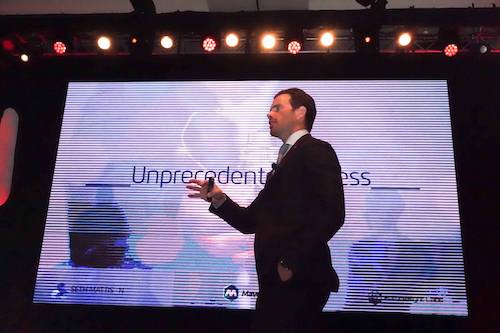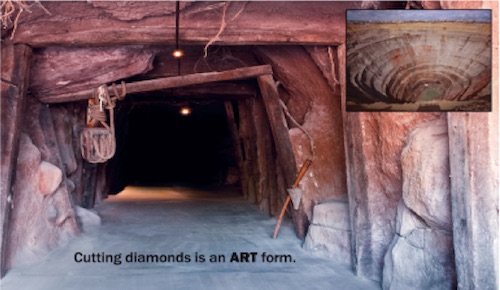Articles and News
Centurion Speaker Reveals Hidden Generation-Gap Pitfalls That Hurt Business | March 15, 2017 (2 comments)

Scottsdale, AZ—Seth Mattison, founder and chief movement officer of FutureSight Labs, is an expert on workplace trends and generational dynamics. Speaking at Centurion Scottsdale as part of its “Generations” theme, his presentation, “Future Forces: Insights and Strategies to Engage the Next Generation of Talent and Consumers,” showed how key workplace shifts impact independent jewelers and other family-owned jewelry companies.
“You can’t talk about the future without having some perspective on the past and knowing where you came from and what made you successful, but you also don’t want to hold so tightly that you miss what happens next,” he said.
Mindsets are instilled very early in people’s lives, said Mattison. He himself grew up on a fourth-generation farm in Minnesota, and worked alongside his father, grandfather, and great-grandfather.
“My great-grandfather was born in 1910. He was a remarkable man. He had so much wisdom and knowledge. But he also was the type of guy who, when he shook your hand, was secretly checking for calluses and judging you.”
Acknowledging how many businesses are overwhelmed by trying to figure out Millennials, he suggests a new way of thinking about the tension between generations: hierarchies—the old traditional order of the workplace—vs. networks, which is the future—and how Millennials are wired.
“We are entering an age that will come to be known as Age of Networks. All around us, thanks to the digitization of everything, we are living in a society based on networks; of information, people, and education.
But the world in which Boomers and Gen-X came of age has a deeply embedded culture of structure and hierarchy. “These two cultures are at battle today. Most of us are not consciously aware of it, but I have not met a single executive that doesn’t feel it,” he said.
A traditional organization chart represents a view of world that is so ingrained people are not even aware of it. For example, consider workplace language: “The higher-ups have a meeting in that room.” “When we get back from the conference we have to communicate this info down to the troops or up the chain.”
“Anyone working more than 12-15 years has a whole list of unwritten rules. The recipe for success: ‘start on the bottom,’ ‘keep your head down and mouth shut,’ ‘work your tail off and good things will happen,’ ‘keep your nose to the grindstone,’ ‘pay your dues,’ etc. You know these. They’ve developed an unbelievable work ethic and willingness to take the hill,” said Mattison. There’s also the unwritten rule of respecting the chain of command: you do not go above your boss’s head.
But another unwritten rule is that if you want to be successful, you don’t tell anyone what you know because that gives you an edge, power, and security.
“The idea was that if I know this thing and have this skill set and nobody else does, you can’t fire me, I’m safe,” said Mattison. It’s a generational perspective, though: Boomers and Gen-Xers more so than Millennials had to learn how to survive in that world, but since Boomers were getting married, having families, and buying homes almost a full decade sooner than Millennials are today, they had a lot more at risk.
That perspective also gave workers a sense of power, he said. “People have to come to me as a source of influence. I keep my information and product knowledge tight and don’t share. Scarcity equals power,” he said.
But today the people with the most information share it, and those who share the most are the most powerful, he said. “It’s an era of unprecedented access, transparency, and openness, of Julian Assange and Wikileaks. They were around long before the election. Whether you think of them as terrorists or freedom fighters, they are simply what is.”

Seth Mattison at the Centurion Scottsdale show.
The most well-known, universally understood rule is no news is good news, he said. “If you’re not getting yelled at, you’re probably doing just fine. Where is that buried in your DNA and how do you know that? Except research shows that today people would rather hear bad news than no news.
“That’s hugely impactful in family businesses, because owners typically desire to keep information close to the vest. But the human psyche tends to fill open space with worst-case scenarios.” It’s not that we’re trying to be deceptive, he said; it’s that [older workers’] default mode is not set to share.
But younger workers view authority figures as peers, and communities, too, have changed: where they used to be based around ideologies and institutions, such as the town square, the Chamber of Commerce, the VFW, and church, now they’re based on common interests, like foodies, yogis, cross-fitters, etc.
“There’s never been less trust in institutions, and that is only going to elevate,” said Mattison, pointing out that Millennial participation in traditional institutions like marriage, and religious affiliation is way off from prior generations.
Brands that understand this create a better, more transparent relationship with their customers. He pointed to GN Diamond as a jewelry industry example doing it successfully with its VR app and mobile device bringing to life where product comes from.

GN Diamonds' Virtual Reality app takes consumers into a diamond mine.

But when consumers can connect with designers and brands directly, how can retailers compete? Mattison says it’s through storytelling.
“The retailer has curated the best designers, so they also have to be able to communicate the stories. If I’m going to make an investment in this piece, I need the story that goes with it. How many people have sent salespeople to storytelling training? We’ve lost the ability to tell stories. People used to sit around the campfire and tell stories and tap into our tribal nature.
“85% of businesses say the number-one way they will compete is through customer experience. What are experiences you’re creating that are different from the store down street? How do you tap into that entrepreneurial spirit in your community? Could you use your store space for aspiring designers or host education sessions?”
The youth influence is reverberating around the world, he added. “Look at magazine covers 20 years ago, who were the titans? It was old white men like Jack Welch and Lee Iacocca. Now we see faces of individuals barely old enough to shave.”
He acknowledged the challenge is the way their ideas are brought forth sometimes leaves something to be desired. “Today’s younger generation has knowledge of some of the most disruptive trends in the industry, but without the perspective of having years of experience.”
Both sides must have empathy for the other, he stressed. It doesn’t matter how much merit an idea has, older generations were conditioned to believe children were meant to be seen and not heard. But it’s not all on the leaders; the younger side can’t come in with an attitude like ‘You’ve been doing this since 1993? Hasn’t anything changed since then?’
The same holds true for customers today, especially younger customers, who want to be able to reach you as well and to not be told but to be shown. “It’s the idea of discovery. Can I have someone collaborate with me to go on a journey of discovery for the perfect piece of jewelry?”
His final five tips:
- Amplify education
- Discovery not showing
- Redefine the competition
- Redefine your partners
- It’s all about story







